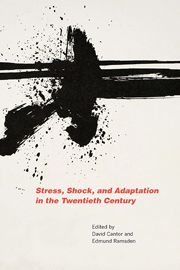Book contents
- Frontmatter
- Contents
- Acknowledgments
- Introduction
- Part One Packaging Stress
- Part Two Trauma and Acute Stress
- Part Three War
- Part Four Work
- Part Five Managing Stress
- Part Six Surveilling Stress
- 11 Stress in the City: Mental Health, Urban Planning, and the Social Sciences in the Postwar United States
- 12 Sadness in Camberwell: Imagining Stress and Constructing History in Postwar Britain
- List of Contributors
- Index
11 - Stress in the City: Mental Health, Urban Planning, and the Social Sciences in the Postwar United States
from Part Six - Surveilling Stress
Published online by Cambridge University Press: 05 April 2014
- Frontmatter
- Contents
- Acknowledgments
- Introduction
- Part One Packaging Stress
- Part Two Trauma and Acute Stress
- Part Three War
- Part Four Work
- Part Five Managing Stress
- Part Six Surveilling Stress
- 11 Stress in the City: Mental Health, Urban Planning, and the Social Sciences in the Postwar United States
- 12 Sadness in Camberwell: Imagining Stress and Constructing History in Postwar Britain
- List of Contributors
- Index
Summary
The Study of Mental Health in the City
The city has long been perceived as a pathological space, a cause of deviance, sickness, and delinquency. Its various social and psychological problems have often been associated with its physical structures and conditions. Perhaps the most famous sociological statement on the city, Louis Wirth's “Urbanism as a Way of Life,” identified size, density, and heterogeneity as resulting in superficiality, alienation, anomie, and various forms of social and psychological breakdown. This chapter focuses on a diverse group of social and behavioral scientists, biologists, psychiatrists, architects, and planners concerned with rectifying the problems associated with urban life. From the mid-1950s they were united in a series of conferences supported by the National Institute of Mental Health (NIMH), to better understand and control the influence of the environment on mental health and illness. The Committee on Physical and Social Environmental Variables as Determinants of Mental Health, nicknamed the “Space Cadets,” met for two and a half days, twice a year, for twelve years from 1956. The meetings, which were fully transcribed, allow us to examine how diverse scientific and professional communities sought to develop a common language and a degree of unity of purpose in addressing the issues of slum clearance and urban renewal. Many of those involved saw the meetings as having significantly influenced their future research, as John B. Calhoun suggested: “I will leave it to historians to start with the stenotype transcripts of the twenty-three 2½-day sessions and follow them outward.”
- Type
- Chapter
- Information
- Stress, Shock, and Adaptation in the Twentieth Century , pp. 291 - 319Publisher: Boydell & BrewerPrint publication year: 2014

